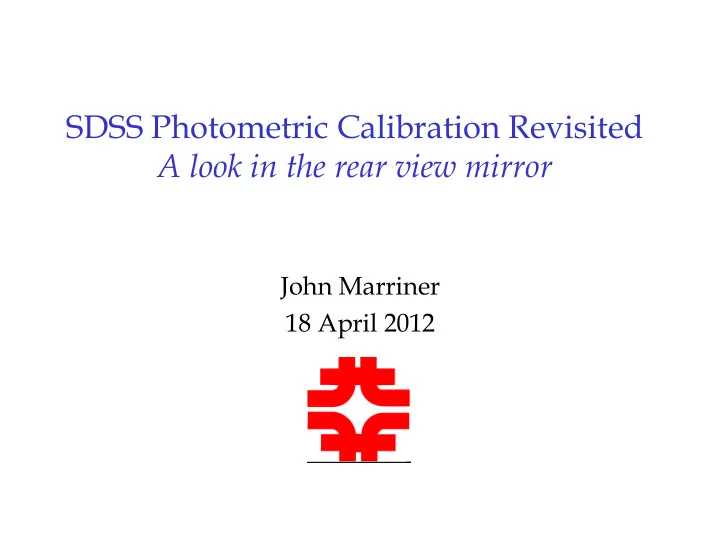

SDSS Photometric Calibration Revisited A look in the rear view mirror John Marriner 18 April 2012
Cosmology with SN The desire to determine SN magnitudes from measurements of different parts of the spectrum is a driver for precise photometric calibration. Comparison of different experiments requires an “absolute” calibration. Photometry is typically difference photometry relative to field stars. SN magnitudes vary by ~7% Errors are reduced by averaging many SN. Random calibration errors are a minor concern. Even small systematic biases can cause problems.
SDSS SN Calibration Strategy Report “native magnitudes” Measure filter response (relative throughput) Calibrate absolute response with standard stars whose Spectrum is well measured. Photometric response of the SDSS telescope is measured. Measurements of the standard stars are reported as an “AB offset” Consider only stripe 82
Details The Photometric Telescope (PT) Measures atmospheric extinction based on primary standards (the USNO standards). Measures unknown field stars for use as secondary calibration standards. The 2.5 m Survey Telescope is calibrated using the secondary calibration standards measured by the PT. The 2.5 m Telescope is normally operated in drift scan mode.
Filter Measurements From Doi (2010)
More Filters
Flat-field Stability #$#9 ? 2 3 #$#% * @ :;4/<(,--'3/*+/='3.>.*+- #$#8 #$#7 #$#6 #$#" # !" !#$% # #$% " &'()*+,-*.+/01'23''45
Rms Measurement Variation
PT Flat Field "#% "#% "#% 7 ! : 7 ! : 7 ! : "#$ "#$ "#$ (,;;)2)-*)1,-1<.6-,/=8) (,;;)2)-*)1,-1<.6-,/=8) (,;;)2)-*)1,-1<.6-,/=8) " " " !"#$ !"#$ !"#$ !"#% !"#% !"#% !"#$ " "#$ "#% "#& "#' !"#$ " "#$ "#% "#& "#' !"#$ " "#$ "#% "#& "#' ()*+,-./,0-12)+./,3)1/01-04,-.+150,-/,-6178)62))9: ()*+,-./,0-12)+./,3)1/01-04,-.+150,-/,-6178)62))9: ()*+,-./,0-12)+./,3)1/01-04,-.+150,-/,-6178)62))9: "#% "#% "#"9 7 ! : 7 ! : "#"$ "#$ "#$ (,;;)2)-*)1,-1<.6-,/=8) (,;;)2)-*)1,-1<.6-,/=8) :055)*/,0-12;.4-,/<3)7 "#"8 " " " !"#$ !"#$ !"#"8 !"#% !"#% !"#"$ !"#$ " "#$ "#% "#& "#' !"#$ " "#$ "#% "#& "#' !"#$ " "#$ "#% "#& "#' ()*+,-./,0-12)+./,3)1/01-04,-.+150,-/,-6178)62))9: ()*+,-./,0-12)+./,3)1/01-04,-.+150,-/,-6178)62))9: ()*+,-./,0-123)45))67
What is the Ideal Star Flat Dither Pattern? Rely on dome flats for high spatial scales. Dither by 1/2, 1/4, 1/8, …? ∑ a n e inkx ( ) = f x n ∑ ( ) e inkx a n 1 − e inkh ( ) − f ( x ) = f x + h n 1 e − inkx f x + h ∫ [ ] ( ) − f ( x ) ⇒ a n = dx 1 − e inkh
PT Response Map
A Tale of 2 Catalogs Stripe 82 Coadd (Ivezic) Uses PT response for magnitude (r-band) Uses stellar locus for colors Multiple measurements, outliers & variables rejected DR8 (Ubercal) “Insensitive” to PT response Color uncalibrated Single epoch catalog
Coadd/DR8 Comparison
PT Observation Times 7$ 7% 7# 8'9/+2:8+)1;4-5 6 " $ % # !"# !$# !%# # %# $# "# &'()*+,-./0-'10+23/(4//-5
Comparison Coadd/DR8 fits as a function of declination
Variability of the Calibration #$#6 !%%><?>!@# 035 !7%><?># %><?>@# 8,2+*-91'/1*::'3'+('/0;.,11!&<=5 @%><?>A# #$#7 !A#><?>A# # !#$#7 !#$#6 !" !#$% # #$% " &'()*+,-*.+/01'23''45
All 5 Bands #$" #$#6 #$#6 !%%<:=<!># !%%?=<?!@# !%%><?>!@# !?%<:=<# 075 025 035 !7%?=<?# !7%><?># %<:=<># 6,2+*-71'/1*88'3'+('/09.,11!&:;5 8,2+*-91'/1*::'3'+('/0;.<11!&=>5 %?=<?@# 8,2+*-91'/1*::'3'+('/0;.,11!&<=5 %><?>@# >%<:=<@# @%?=<?A# @%><?>A# !@#<:=<@# #$#% #$#7 #$#7 !A#?=<?A# !A#><?>A# # # # !#$#% !#$#7 !#$#7 !#$" !#$#6 !#$#6 !" !#$% # #$% " !" !#$% # #$% " !" !#$% # #$% " &'()*+,-*.+/01'23''45 &'()*+,-*.+/01'23''45 &'()*+,-*.+/01'23''45 #$#6 #$#6 !%%><?>!@# !%%><?>!@# 0*5 0B5 !7%><?># !7%><?># %><?>@# %><?>@# 8,2+*-91'/1*::'3'+('/0;.,11!&<=5 8,2+*-91'/1*::'3'+('/0;.,11!&<=5 @%><?>A# @%>3,>A# #$#7 #$#7 !A#><?>A# !A#><?>A# # # !#$#7 !#$#7 !#$#6 !#$#6 !" !#$% # #$% " !" !#$% # #$% " &'()*+,-*.+/01'23''45 &'()*+,-*.+/01'23''45
AB Offsets Standard u g r i z Solar -0.0660 0.0202 0.0052 0.0207 0.0125 Solar Error 0.0068 0.0035 0.0027 0.0057 0.0070 BD+17°4708 -0.0541 0.0158 -0.0021 0.0099 -0.0054 WD Average -0.0455 0.0173 0.0037 0.0168 0.0059 WD Error 0.0149 0.0014 0.0030 0.0035 0.0057 Error u g r i z PT Measurement 0.0026 0.0015 0.0013 0.0025 0.0018 Color Transform 0.0029 0.0009 0.0008 0.0009 0.0017 HST Measurement 0.0056 0.0031 0.0022 0.0050 0.0066 SDSS Filters ? ? ? ? ? HST Calibration ? ? ? ? ?
Conclusions Calibration is only as good as the weakest link (PT filters & flat field). Atmospheric extinction measurements are needed more frequently than once per night. S tar flats are critical for precise flat-fields. “Frequent” calibrations are necessary (filters & flat field? & atmospheric extinction?) Redundancy is a key to understanding Many standard stars Multiple overlapping “star flats” Cross-calibration with other surveys A transparent calibration technique is important.
Stellar Color/Color Plots
Recommend
More recommend